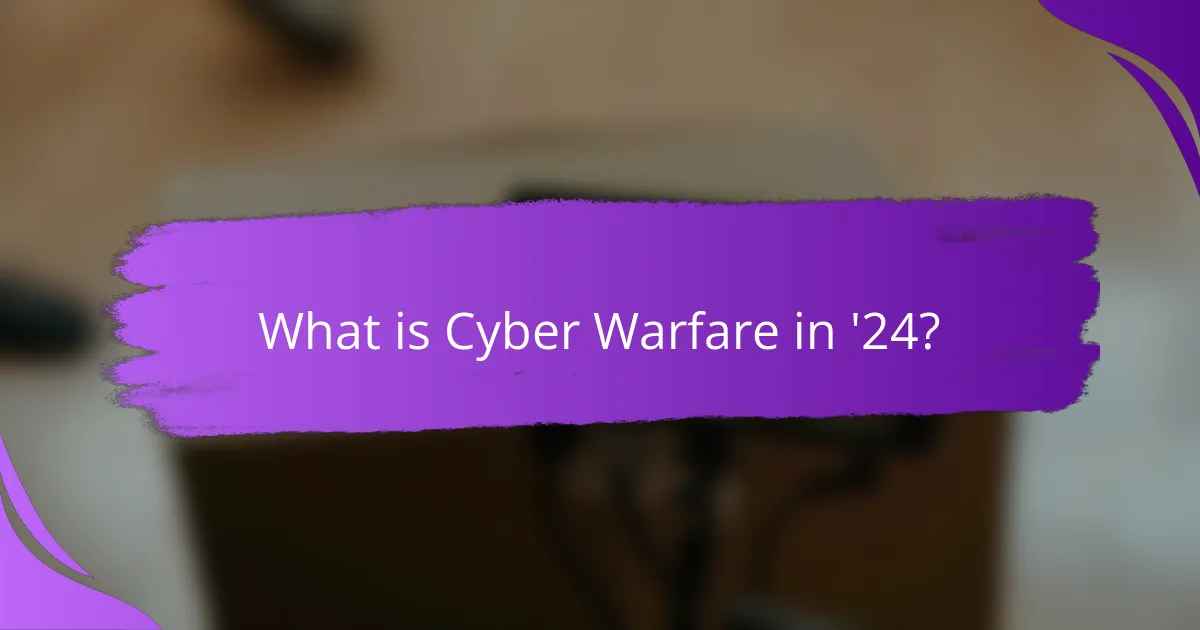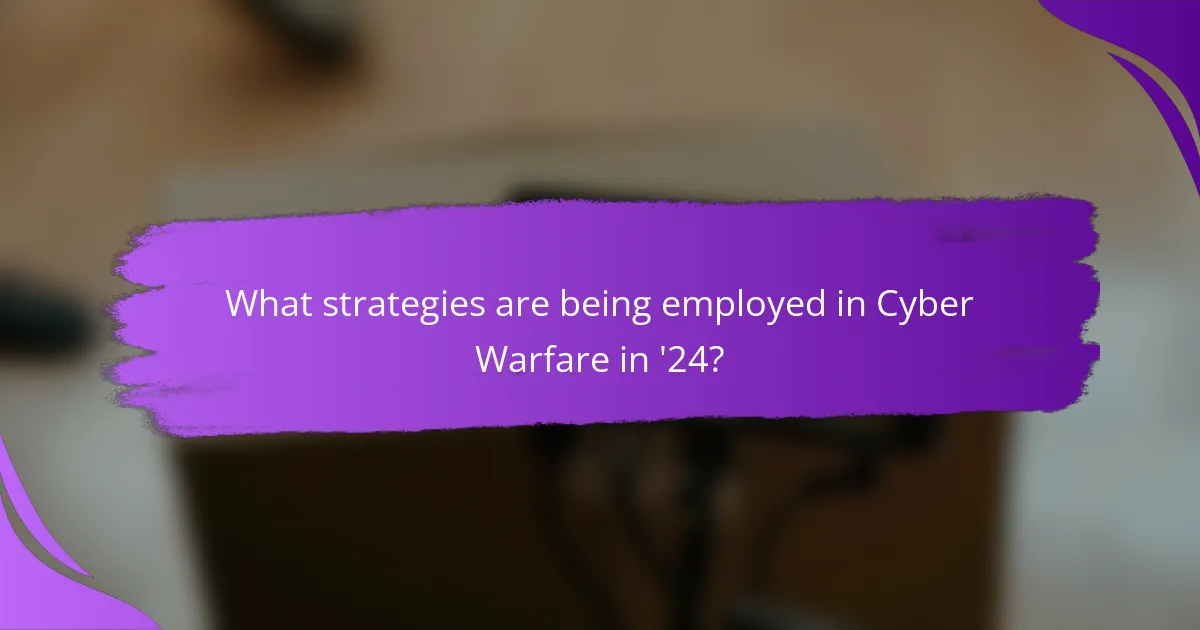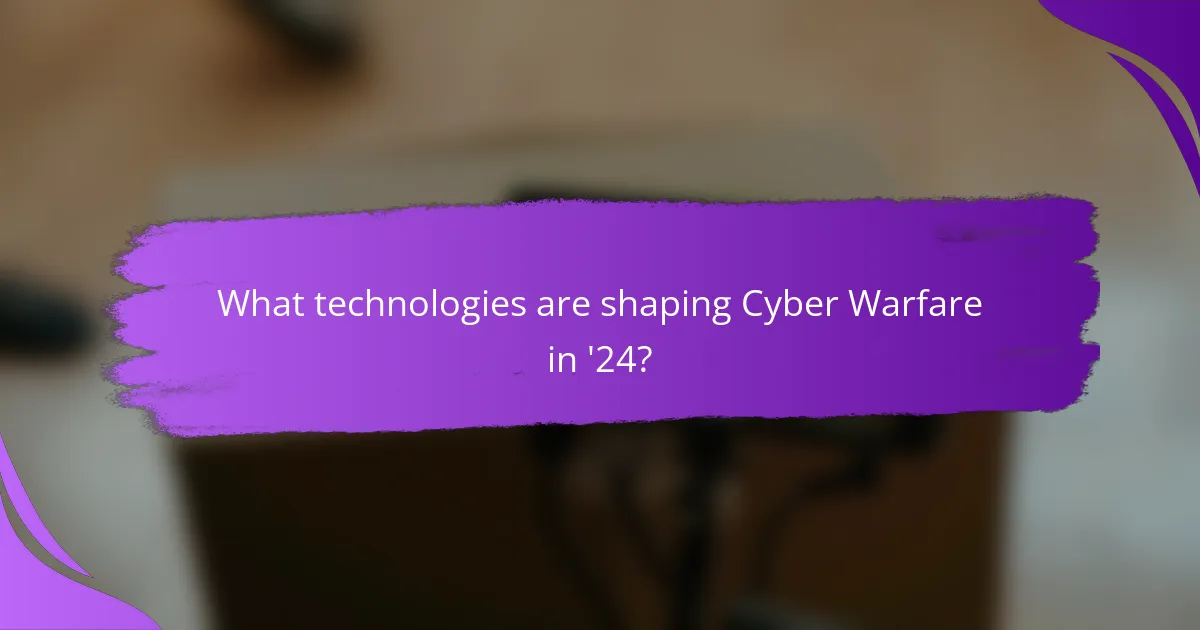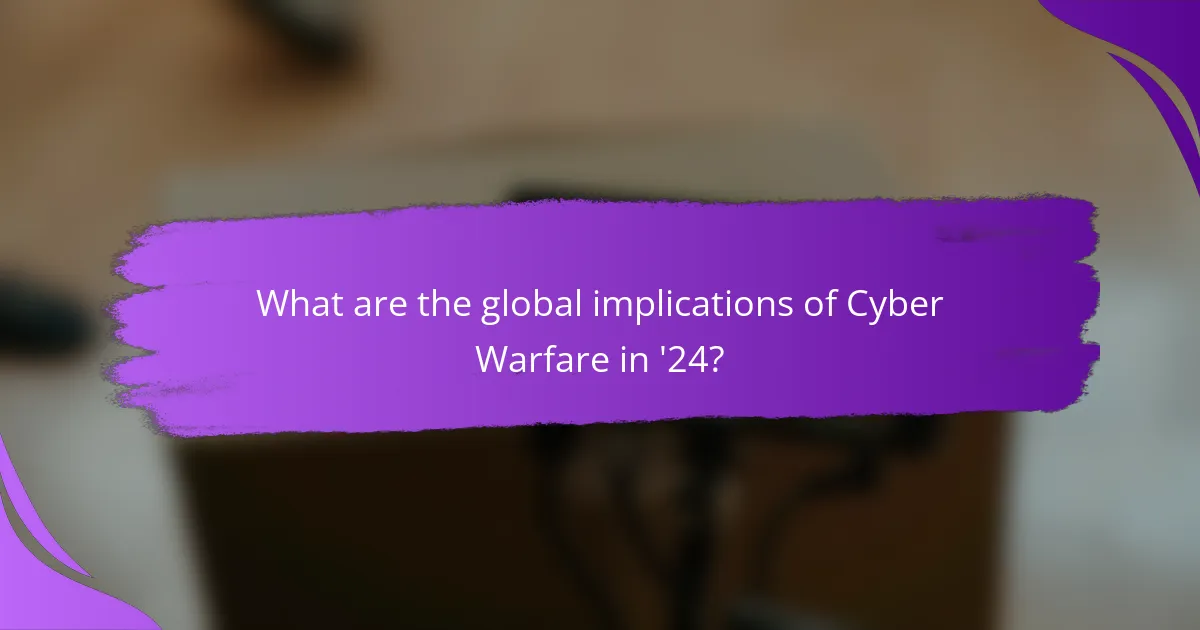Cyber warfare in 2024 encompasses the use of digital attacks by nation-states to disrupt, damage, or control adversaries’ information systems. Key strategies include advanced persistent threats (APTs), supply chain attacks, and cyber espionage, with a notable increase in ransomware targeting critical infrastructure. The integration of advanced technologies such as artificial intelligence, quantum computing, and blockchain is enhancing both offensive and defensive cyber capabilities. As the frequency of cyber incidents rises, nations are collaborating to share threat intelligence, reflecting a shift towards more coordinated cyber operations. The implications of these developments are significant, affecting global security, economic stability, and the evolution of international laws regarding cyber warfare.

What is Cyber Warfare in ’24?
Cyber warfare in ’24 refers to the use of digital attacks by nation-states to disrupt, damage, or control information systems of adversaries. This includes tactics such as hacking, malware deployment, and data theft. In ’24, cyber warfare has evolved with advanced technologies like AI and machine learning, enhancing both offensive and defensive capabilities. Nation-states are increasingly targeting critical infrastructure, including power grids and financial systems. The frequency of cyber attacks has risen, with significant incidents reported globally. Reports indicate that cyber incidents have caused billions in damages annually. As conflicts escalate, cyber warfare is becoming a central aspect of national security strategies.
How has the definition of cyber warfare evolved leading into ’24?
The definition of cyber warfare has evolved to encompass a broader range of tactics and implications. Initially, it primarily referred to state-sponsored attacks targeting critical infrastructure. As technology advanced, the definition expanded to include non-state actors and hybrid warfare tactics. The rise of ransomware attacks and cyber espionage has further changed perceptions. Now, cyber warfare also includes economic disruption and influence operations. By 2024, definitions increasingly acknowledge the role of social media in shaping public opinion during conflicts. This evolution reflects the growing importance of cyber capabilities in modern warfare strategies.
What are the key characteristics of cyber warfare in the current landscape?
Cyber warfare in the current landscape is characterized by advanced technology, state-sponsored attacks, and asymmetric tactics. Modern cyber warfare employs sophisticated malware and ransomware to disrupt critical infrastructure. Nation-states increasingly engage in cyber espionage to gather intelligence. Cyber attacks are often deniable, complicating attribution and response. The frequency of attacks has escalated, with significant incidents reported globally. Cyber warfare strategies integrate cyber capabilities with conventional military operations. Additionally, the rise of hacktivism introduces a new dimension to cyber conflicts. The evolving landscape necessitates continuous adaptation of defense mechanisms.
How do nation-states define their cyber warfare strategies?
Nation-states define their cyber warfare strategies through a combination of national security policies, threat assessments, and technological capabilities. They analyze potential adversaries and their cyber capabilities. Strategies often include offensive and defensive measures. Offensive strategies may involve cyber attacks to disrupt enemy infrastructure. Defensive strategies focus on protecting critical assets from cyber threats. Additionally, nation-states collaborate with private sectors for intelligence sharing. They also participate in international agreements to establish norms for cyber conduct. Historical examples include the Stuxnet attack on Iran, showcasing the strategic use of cyber capabilities. These definitions and frameworks evolve as technology and geopolitical landscapes change.
Why is understanding cyber warfare in ’24 crucial for global security?
Understanding cyber warfare in ’24 is crucial for global security due to the increasing frequency and sophistication of cyber attacks. These attacks target critical infrastructure, financial systems, and government operations. In 2022, cyber incidents cost the global economy approximately $6 trillion. Nations are investing in cyber capabilities to protect against and conduct cyber operations. The rise of state-sponsored cyber activities poses significant threats to national security. Additionally, the potential for cyber warfare to escalate into physical conflicts is a growing concern. As technology evolves, understanding its implications is vital for defense strategies. Cyber warfare can disrupt communication and undermine public trust in institutions. Therefore, awareness and preparedness are essential for maintaining global stability.
What are the potential threats posed by cyber warfare to national security?
Cyber warfare poses significant threats to national security. It can disrupt critical infrastructure, such as power grids and transportation systems. Cyber attacks can lead to the theft of sensitive government and military data. This compromises national defense strategies and operational capabilities. Additionally, cyber warfare can undermine public trust in government institutions. It may also incite economic instability through attacks on financial systems. The 2015 cyberattack on Ukraine’s power grid is a notable example of such threats. This incident left hundreds of thousands without electricity, showcasing the potential for widespread chaos.
How can cyber warfare impact civilian infrastructure?
Cyber warfare can severely disrupt civilian infrastructure. It targets essential services such as power grids, water supply systems, and transportation networks. For instance, the 2015 Ukraine power grid attack left over 200,000 people without electricity. Cyber attacks can cause operational failures, leading to widespread chaos and panic. They can also compromise sensitive data, affecting public safety and trust. The increasing reliance on digital systems makes civilian infrastructure vulnerable. Historical incidents demonstrate the potential for significant economic and social repercussions. Cyber warfare poses a growing threat to the stability of modern societies.

What strategies are being employed in Cyber Warfare in ’24?
In 2024, strategies in cyber warfare focus on advanced persistent threats (APTs) and supply chain attacks. APTs involve prolonged and targeted cyberattacks aimed at stealing data or compromising systems. These attacks often utilize sophisticated techniques to bypass traditional security measures. Supply chain attacks exploit vulnerabilities in third-party vendors to infiltrate larger organizations.
Additionally, nations are employing cyber espionage to gather intelligence. This involves infiltrating networks to obtain sensitive information. Another strategy is the use of ransomware to disrupt critical infrastructure. Ransomware attacks have increased significantly, targeting hospitals and energy sectors.
Furthermore, there is a rise in cyber defense collaboration among nations. Countries are sharing threat intelligence to enhance their cybersecurity posture. This cooperative approach aims to mitigate risks and respond effectively to attacks.
Overall, these strategies reflect a shift towards more aggressive and coordinated cyber operations in 2024.
What are the primary offensive strategies used in cyber warfare?
The primary offensive strategies used in cyber warfare include malware deployment, denial-of-service attacks, and phishing campaigns. Malware deployment involves using malicious software to disrupt, damage, or gain unauthorized access to systems. Historical examples include the Stuxnet worm, which targeted Iran’s nuclear facilities. Denial-of-service attacks aim to overwhelm a target’s network, rendering it inoperable. The 2016 DDoS attack on Dyn exemplifies this strategy, affecting major websites. Phishing campaigns manipulate individuals into divulging sensitive information. According to the Anti-Phishing Working Group, phishing attacks increased by 22% in 2020, highlighting their prevalence.
How do nation-states deploy malware and ransomware as offensive tools?
Nation-states deploy malware and ransomware as offensive tools to disrupt, damage, or gain intelligence on adversaries. They often target critical infrastructure, financial systems, and governmental networks. For example, the 2020 SolarWinds attack involved sophisticated malware that infiltrated multiple U.S. government agencies. This allowed the attackers to gather sensitive information over an extended period. Ransomware attacks, like the Colonial Pipeline incident in 2021, can cripple essential services and prompt compliance through financial extortion. These offensive strategies are often part of broader cyber warfare tactics aimed at achieving political or military objectives. Cybersecurity firms report increasing incidents of state-sponsored cyberattacks, indicating a growing trend in this area.
What role does social engineering play in cyber warfare strategies?
Social engineering plays a critical role in cyber warfare strategies. It involves manipulating individuals to gain confidential information. Attackers often exploit human psychology to bypass technical defenses. For instance, phishing attacks are common methods used to deceive targets. According to the 2021 Verizon Data Breach Investigations Report, 36% of data breaches involved social engineering tactics. This highlights the effectiveness of such strategies in compromising security. Social engineering enhances the overall impact of cyber warfare by targeting the human element. It can lead to significant data theft, system breaches, and operational disruption.
What defensive strategies are essential for countering cyber threats?
Essential defensive strategies for countering cyber threats include implementing firewalls, intrusion detection systems, and regular software updates. Firewalls act as barriers between trusted internal networks and untrusted external networks, preventing unauthorized access. Intrusion detection systems monitor network traffic for suspicious activity and can alert administrators to potential breaches. Regular software updates patch vulnerabilities that cybercriminals may exploit. Additionally, employee training on cybersecurity best practices reduces the risk of social engineering attacks. Multi-factor authentication adds an extra layer of security by requiring multiple forms of verification. Regular security audits assess the effectiveness of existing defenses. According to the Cybersecurity & Infrastructure Security Agency, organizations implementing these strategies significantly reduce their risk of cyber incidents.
How can organizations enhance their cybersecurity posture in ’24?
Organizations can enhance their cybersecurity posture in ’24 by adopting a multi-layered security approach. This includes implementing advanced threat detection systems and regular security audits. Training employees on cybersecurity best practices is also essential. Additionally, integrating artificial intelligence can help identify vulnerabilities in real-time. According to a report by Cybersecurity Ventures, global spending on cybersecurity is expected to exceed $1 trillion from 2021 to 2025. This highlights the increasing importance of investment in cybersecurity infrastructure. Regularly updating software and systems can mitigate risks from known vulnerabilities. Establishing a robust incident response plan prepares organizations for potential breaches.
What are the best practices for incident response in cyber warfare?
Best practices for incident response in cyber warfare include preparation, detection, analysis, containment, eradication, recovery, and lessons learned. Organizations should develop an incident response plan before incidents occur. Regular training and simulations enhance team readiness. Continuous monitoring of networks helps in early detection of threats. Analyzing incidents allows for understanding the attack vectors. Containment strategies limit the spread of the attack. Eradication ensures that threats are completely removed from systems. Recovery processes restore systems to normal operations. Conducting post-incident reviews helps improve future responses. According to the Cybersecurity & Infrastructure Security Agency (CISA), these steps are crucial for effective incident management.

What technologies are shaping Cyber Warfare in ’24?
Artificial intelligence, quantum computing, and blockchain are shaping Cyber Warfare in ’24. AI enhances threat detection and response capabilities. It enables automated systems to analyze vast data quickly. Quantum computing offers unprecedented processing power for cryptography. This technology can break traditional encryption methods. Blockchain provides secure communication and data integrity. It ensures transparency in operations and prevents tampering. Cybersecurity tools are increasingly leveraging these technologies. Their integration improves defensive and offensive strategies in cyber conflicts.
How is artificial intelligence influencing cyber warfare tactics?
Artificial intelligence is significantly influencing cyber warfare tactics by enhancing threat detection and response capabilities. AI algorithms analyze vast amounts of data to identify patterns indicative of cyber threats. This enables quicker responses to attacks, reducing potential damage. Additionally, AI is used to automate tasks such as vulnerability assessments and [censured] testing. The integration of machine learning improves the adaptability of cyber defense systems. These systems can learn from previous attacks and evolve accordingly. For instance, AI-driven tools can simulate potential attack scenarios to bolster defenses. Reports indicate that organizations employing AI in cybersecurity experience reduced incident response times by up to 50%. Thus, AI is transforming the landscape of cyber warfare through improved efficiency and effectiveness.
What are the implications of AI-driven cyber attacks?
AI-driven cyber attacks can lead to significant disruptions in cybersecurity. These attacks can automate and enhance the scale of threats. They enable attackers to exploit vulnerabilities faster than traditional methods. AI can analyze vast amounts of data to identify weaknesses in systems. This makes it easier for cybercriminals to launch targeted attacks.
The implications extend to critical infrastructure. AI attacks can disrupt services like power grids and healthcare systems. A report by the World Economic Forum highlighted that AI could increase the frequency of cyber incidents. It also noted that 70% of organizations believe AI will change their cybersecurity strategy.
Moreover, AI can create sophisticated phishing schemes. These schemes can trick users into revealing sensitive information. The result is a higher risk of identity theft and financial loss. Organizations must adapt their defenses to counter these evolving threats.
How can AI be used for defense against cyber threats?
AI can be used for defense against cyber threats by enhancing threat detection and response capabilities. Machine learning algorithms can analyze vast amounts of data to identify unusual patterns. These patterns often indicate potential cyber attacks. AI systems can also automate responses to detected threats, reducing the response time significantly. For instance, in 2020, IBM reported that AI-driven security systems could reduce incident response times by up to 80%. Additionally, AI can predict future threats by analyzing historical data and trends. This predictive capability allows organizations to fortify their defenses proactively. AI tools can also assist in vulnerability management by identifying weaknesses in systems before they can be exploited.
What role do emerging technologies play in cyber warfare?
Emerging technologies significantly enhance capabilities in cyber warfare. They enable advanced cyber attacks and defense mechanisms. Technologies such as artificial intelligence and machine learning improve threat detection and response times. Quantum computing offers unprecedented processing power, potentially breaking existing encryption methods. Blockchain technology can enhance data integrity and security. The integration of Internet of Things (IoT) devices expands attack surfaces for adversaries. Drones and autonomous systems can conduct surveillance and deliver cyber operations remotely. These technologies collectively transform the landscape of cyber warfare, making it more complex and dynamic.
How are quantum computing and blockchain impacting cybersecurity?
Quantum computing and blockchain are significantly impacting cybersecurity. Quantum computing introduces the potential to break traditional encryption methods. This poses a risk to data security as quantum algorithms can solve complex problems much faster than classical computers. For example, Shor’s algorithm can factor large numbers efficiently, threatening RSA encryption widely used today.
On the other hand, blockchain technology enhances cybersecurity through its decentralized and immutable nature. It provides secure transaction methods and reduces the risk of data tampering. Each transaction on a blockchain is recorded in a way that is transparent and cannot be altered without consensus from the network.
The combination of these technologies creates a dual effect. Quantum computing challenges existing security frameworks, while blockchain offers innovative solutions to bolster data integrity and security. As such, organizations must adapt their cybersecurity strategies to address these emerging challenges and opportunities.
What advancements in encryption are crucial for protecting data?
Advancements in encryption crucial for protecting data include quantum encryption, homomorphic encryption, and advanced symmetric algorithms. Quantum encryption uses quantum key distribution to secure data against eavesdropping. This technology ensures that any attempt to intercept the key alters the data, making it detectable. Homomorphic encryption allows computations on encrypted data without needing to decrypt it. This capability enables secure data processing in cloud environments. Advanced symmetric algorithms, like AES-256, provide robust encryption for data at rest and in transit. These algorithms are widely adopted due to their strength and efficiency. Collectively, these advancements enhance data security in an increasingly digital world.

What are the global implications of Cyber Warfare in ’24?
Cyber warfare in 2024 will have significant global implications. Nations will increasingly rely on cyber capabilities for strategic advantages. This reliance may escalate tensions between countries, leading to potential conflicts. Economic stability could be threatened by cyber attacks on critical infrastructure. Data breaches may compromise national security and sensitive information. The global economy could suffer from disruptions in trade due to cyber incidents. International laws and norms regarding cyber warfare will likely evolve. Cooperation among nations to combat cyber threats will become essential.
How does cyber warfare affect international relations and diplomacy?
Cyber warfare significantly impacts international relations and diplomacy by altering power dynamics among nations. It creates new avenues for conflict that are less visible than traditional warfare. Countries can engage in cyber attacks without direct military confrontation. This allows for plausible deniability, complicating diplomatic responses. For example, the 2016 U.S. elections were influenced by Russian cyber interference, straining U.S.-Russia relations. Additionally, cyber warfare can lead to retaliatory measures that escalate tensions. Nations may form alliances based on shared cybersecurity threats, reshaping diplomatic landscapes. The rise of cyber capabilities has also prompted discussions on international norms and regulations for state behavior in cyberspace.
What are the consequences of cyber warfare on global alliances?
Cyber warfare significantly impacts global alliances by creating distrust among nations. It leads to increased tensions and a reevaluation of security strategies. Countries may strengthen their cyber defenses in response to perceived threats. This often results in the formation of new coalitions focused on cybersecurity. For example, NATO has emphasized cyber defense in its strategic framework. Cyber incidents can also strain diplomatic relations, as nations may retaliate or impose sanctions. Furthermore, the lack of clear attribution in cyber attacks complicates accountability. Consequently, nations may adopt a more cautious approach to international cooperation.
How can countries collaborate to mitigate cyber threats?
Countries can collaborate to mitigate cyber threats through information sharing and joint cybersecurity initiatives. Establishing frameworks for sharing threat intelligence enhances collective defense. Collaborative exercises and simulations can improve readiness and response capabilities. Joint task forces can investigate cyber incidents and share best practices. Agreements on legal frameworks facilitate cross-border cooperation. Countries can also align on standards for cybersecurity protocols. International organizations can provide platforms for dialogue and coordination. These collaborative efforts can significantly reduce vulnerabilities and enhance global cybersecurity resilience.
What ethical considerations arise from the use of cyber warfare?
Ethical considerations in cyber warfare include the potential for civilian harm and the violation of sovereignty. Cyber attacks can disrupt essential services, leading to unintended consequences for non-combatants. The distinction between military and civilian targets becomes blurred in cyberspace. This raises moral questions about proportionality and necessity in warfare. Additionally, cyber warfare can lead to escalation and retaliation, potentially resulting in broader conflicts. The lack of clear international laws governing cyber operations complicates accountability. Ethical frameworks are needed to guide nations in responsible cyber conduct.
How do laws of war apply to cyber conflict?
Laws of war apply to cyber conflict by extending existing legal frameworks to digital actions. This includes principles such as distinction, proportionality, and necessity. Distinction requires parties to differentiate between combatants and civilians in cyber operations. Proportionality prohibits attacks that would cause excessive civilian harm relative to military advantage. Necessity limits actions to those essential for achieving a legitimate military objective. The Tallinn Manual, a comprehensive guide on international law applicable to cyber warfare, reinforces these principles. It emphasizes that cyber operations must comply with the same legal standards as traditional military actions. Thus, cyber conflict is subject to international humanitarian law, ensuring accountability and protection of non-combatants.
What are the moral implications of targeting civilian infrastructure?
Targeting civilian infrastructure raises significant moral implications. It challenges the principles of distinction and proportionality in warfare. Civilian infrastructure is essential for the survival and well-being of non-combatants. Attacks on such targets can lead to widespread suffering and loss of life. The Geneva Conventions prohibit attacks that do not distinguish between military and civilian targets. Historical examples, like the bombings in World War II, illustrate the devastating impact on civilian populations. Ethical frameworks emphasize the need to minimize harm to civilians in conflict. Thus, targeting civilian infrastructure is often viewed as a violation of moral and humanitarian standards.
What are the best practices for organizations to prepare for cyber warfare?
Organizations should implement a multi-layered cybersecurity strategy to prepare for cyber warfare. This includes conducting regular risk assessments to identify vulnerabilities. Establishing a robust incident response plan is crucial for effective management of cyber threats. Training employees on cybersecurity awareness helps mitigate human error. Utilizing advanced threat detection technologies can enhance an organization’s defense mechanisms. Regularly updating software and systems protects against known vulnerabilities. Collaborating with government and industry partners strengthens collective security efforts. These practices are supported by data indicating that organizations with comprehensive cybersecurity measures experience fewer breaches.
Cyber warfare in ’24 refers to the strategic use of digital attacks by nation-states to disrupt and control adversaries’ information systems, employing tactics such as hacking, malware deployment, and data theft. This article explores the evolution of cyber warfare definitions, key characteristics, and the offensive and defensive strategies employed by nations. It highlights the implications of emerging technologies like artificial intelligence and quantum computing, as well as the global consequences of cyber warfare on international relations and security. Additionally, the article addresses ethical considerations and best practices for organizations to prepare for potential cyber threats.